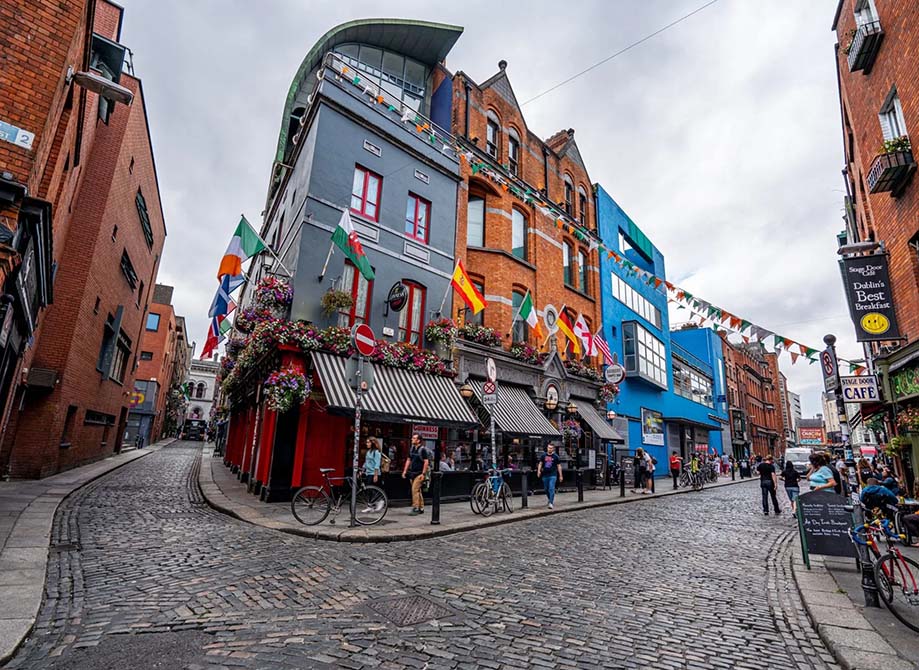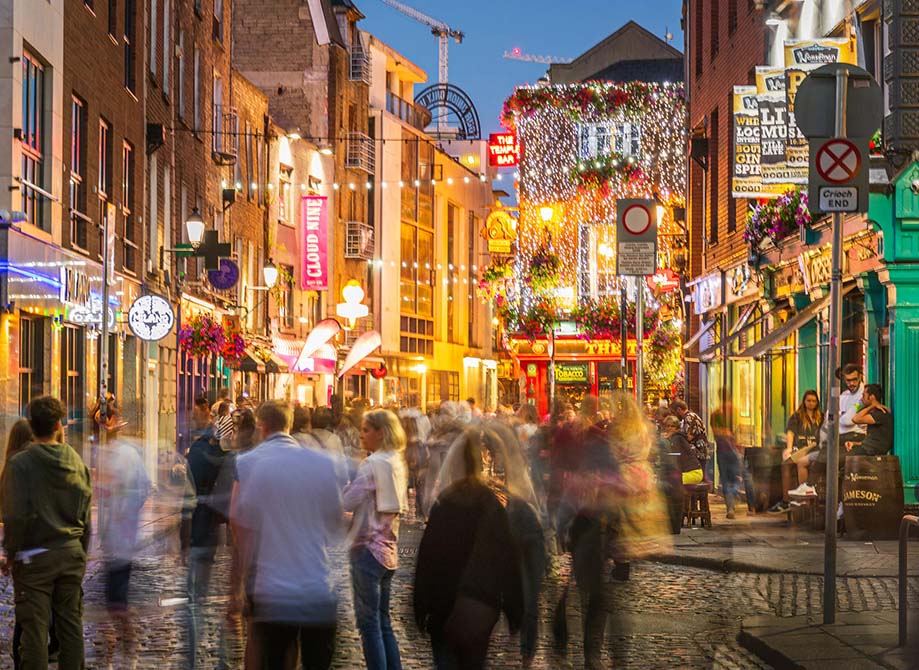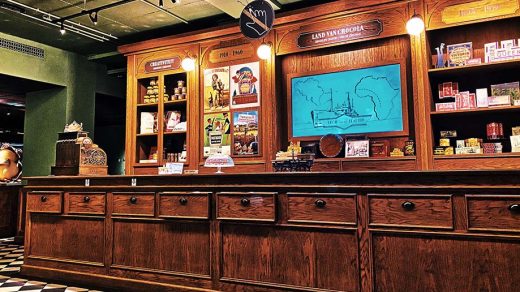I’m all set to embark on my Dublin resort adventure, and a successful trip starts with proper preparation. Here are some essential tips and insights to ensure a smooth and enjoyable experience:
Essential Travel Gear:
Packing smart for a trip to Dublin is crucial for a comfortable and enjoyable experience. Here’s an expanded look at why these travel essentials are so important:
Universal Adapter: Dublin, like many parts of Europe, uses a Type G plug, which has three rectangular pins. Having the right adapter is crucial to charge your electronic devices. Without it, you might find yourself unable to use or charge your devices, causing inconvenience and potentially disrupting your plans, especially if you rely on gadgets for navigation or communication.
Weather-Appropriate Clothing: Dublin’s weather is famously changeable. It’s common to experience a mix of sunshine, rain, and occasional gusts of wind—all in one day. Having layers and weather-appropriate clothing is vital to stay comfortable throughout the day. A waterproof jacket is particularly essential to shield yourself from unexpected showers. Comfortable shoes are a must, especially if you plan on exploring the city on foot. Versatile clothing allows you to adapt to changing weather conditions without carrying too much luggage.
Local Currency: While credit cards are widely accepted in Dublin, having some cash in euros is beneficial, especially when dealing with smaller vendors, markets, or public transportation. Some places might not accept cards for smaller purchases, and having cash on hand ensures you won’t encounter any payment issues. Additionally, it’s advisable to have some coins for small transactions or tipping in certain situations where using a card might not be feasible or convenient.
These essentials ensure you’re well-prepared for various situations you might encounter during your travels in Dublin, safeguarding you against potential inconveniences and allowing for a smoother, more enjoyable trip.
Local Weather and Dress Code:
Dublin’s weather is known for its unpredictability. Be prepared for rain or shine, even within the same day. Opt for layers, including a light sweater, waterproof jacket, and comfortable walking shoes. Locals tend to dress casually, but you might want to bring a nice outfit for dining out at fancier places.
Understanding Local Culture:
Embracing Irish culture is not just about experiencing the sights; it’s about immersing yourself in the warmth and friendliness of the locals. Here’s a more detailed look at why embracing Irish customs and culture is so rewarding:
Politeness and Respect: The Irish are known for their friendliness and hospitality. Being polite, respectful, and friendly to locals helps create a positive interaction and fosters a deeper connection with the culture. Simple gestures like a warm smile or a friendly greeting can go a long way in initiating conversations and making new connections.
Engaging in Conversations: Irish people are often open to conversations and enjoy a good chat. Engaging in conversations with locals—whether it’s about their favorite spots in the city, Irish history, or even the weather—can lead to insightful experiences and perhaps some local tips or hidden gems you might not find in guidebooks.
Traditional Music in Pubs: Pubs are an integral part of Irish culture, often featuring live traditional music sessions. Visiting these pubs not only allows you to enjoy the lively atmosphere but also provides a genuine taste of Irish musical heritage. Don’t be shy; join in, tap your feet to the rhythm, and soak in the vibrant energy of the music.
Respect for Local Customs: Ireland has a rich tapestry of customs and traditions. Respecting and participating in these customs, whether it’s raising a glass in a traditional toast or attending local festivals and events, shows an appreciation for the local culture and helps you connect more deeply with the community.

Basic Irish Phrases: Learning a few basic Irish phrases like “hello” (Dia duit) and “thank you” (Go raibh maith agat) not only shows respect but also delights the locals. Using these phrases, even if it’s just a simple greeting or expressing gratitude, showcases your interest in their culture and often sparks a smile.
By embracing Irish culture with an open heart and a willingness to engage, you’ll find that the warmth and friendliness of the Irish people enhance your travel experience, making it more enriching and memorable.
Transportation and Metro Insights:
Dublin’s public transport, especially the DART and LUAS, is efficient for getting around. Consider getting a Leap Card for convenient and discounted travel on buses, DART, and LUAS. The Leap Card allows you to easily top up for multiple journeys and saves money compared to single tickets.
Getting a Local SIM Card:
Upon arrival, purchasing a local SIM card is convenient for staying connected. Providers like Three, Vodafone, or Eir offer tourist SIM cards with data and call allowances. You can find these at the airport or local shops.
Planning a 5-Day Mini Itinerary:
Here’s a detailed breakdown of the classic attractions and tips on booking methods, ticket prices, and what to expect:
Day 1 – Explore Dublin’s Heart:
- Trinity College: The Book of Kells and the Long Room are must-sees here. Booking tickets online in advance is advisable, especially during peak seasons. Ticket prices for adults range from €14 to €17.
- Dublin Castle: Guided tours are available, offering insights into its history. Tickets can be purchased on-site or online for around €8 to €12.
- St. Stephen’s Green: A beautiful park with no entry fee, ideal for a leisurely stroll or a picnic. It’s open to the public throughout the day.
Day 2 – Coastal Beauty:
- Howth: No need for advance booking. Just hop on the DART (Dublin Area Rapid Transit) train. The cliff walks are free to explore, and seafood restaurants offer fresh catches.
- Malahide Castle and Gardens: Tickets are available on-site or online for approximately €14 to €16. Guided tours of the castle and the gardens are included.
Day 3 – Historical Journey:
- Kilmainham Gaol: Online booking is highly recommended due to its popularity. Ticket prices range from €8 to €12. Guided tours offer a deeper understanding of Ireland’s history.
- EPIC The Irish Emigration Museum: Tickets can be purchased on-site or online for around €15 to €18. It’s advisable to book in advance during peak times.
Day 4 – Cultural Immersion:
- National Gallery of Ireland: Free entry for most exhibitions, but some special exhibitions may require tickets. Check their website for specific details.
- Grafton Street: No tickets needed for shopping! Enjoy street performances and explore various shops and boutiques.
- Irish Music Session: Some pubs offer live traditional music sessions. Check with local pubs like The Cobblestone or O’Donoghue’s for schedules.
Day 5 – Day Trip Adventure:
- Wicklow Mountains: Tours can be booked through various tour operators or self-driven exploration. Costs vary depending on the type of tour or transportation chosen.
- Kilkenny: Train services or guided tours are available. Attractions like Kilkenny Castle or the Medieval Mile Museum might have separate ticket fees.
For most attractions, booking online in advance, especially during peak seasons, ensures availability and sometimes offers discounted rates. Always check the official websites or contact the attractions for the most current information on ticket prices, timings, and any potential discounts or deals.
Adjusting Your Budget:
Dublin can be pricey, especially in touristy areas. To manage costs, consider having meals at local pubs or cafes off the main tourist routes. Shopping at local markets or opting for free attractions can also help save money.
Recommended Day Trips:

Wicklow Mountains – Glendalough:
Exploring Glendalough’s monastic site amidst the Wicklow Mountains was a surreal experience. The serene setting, surrounded by lush greenery and tranquil lakes, transported me to an ancient time. Walking through the ruins of the monastic city, I felt a profound sense of history and spirituality. The intricate details of the Round Tower and the ancient church were awe-inspiring, echoing tales of centuries past. Hiking through the stunning landscapes, I was captivated by the raw beauty of nature, the towering mountains, and the peacefulness of the glacial valley. It was a moment of reflection, a connection to Ireland’s rich cultural heritage and the sheer magnificence of its natural wonders.
Kilkenny – Kilkenny Castle and City Streets:
Visiting Kilkenny Castle was like stepping into a fairy tale. The castle’s imposing structure, nestled amidst beautifully manicured gardens, exuded an aura of medieval grandeur. Exploring its interior, from the lavishly decorated rooms to the historical artifacts on display, offered a glimpse into the opulent lifestyle of the past. The castle’s rich history, coupled with its stunning architecture, left an indelible mark on my memory. Wandering through Kilkenny’s narrow cobbled streets was akin to a journey through time. The charming cityscape, lined with colorful buildings, quaint shops, and cozy cafes, emanated an old-world charm that was both nostalgic and enchanting. Each corner seemed to hold a story, and every cobblestone seemed to whisper tales of the city’s heritage.
These experiences in Glendalough and Kilkenny were not just sightseeing ventures; they were immersive journeys into Ireland’s cultural tapestry. Each site revealed layers of history and culture, leaving me with a profound appreciation for Ireland’s rich and diverse heritage. The majestic landscapes of Glendalough and the medieval allure of Kilkenny encapsulated the essence of Ireland’s beauty and historical significance, creating memories that I’ll forever cherish.
This trip promises a blend of cultural exploration, scenic beauty, and historical insights. With these tips in hand, I’m ready to make the most of my Dublin resort getaway!






